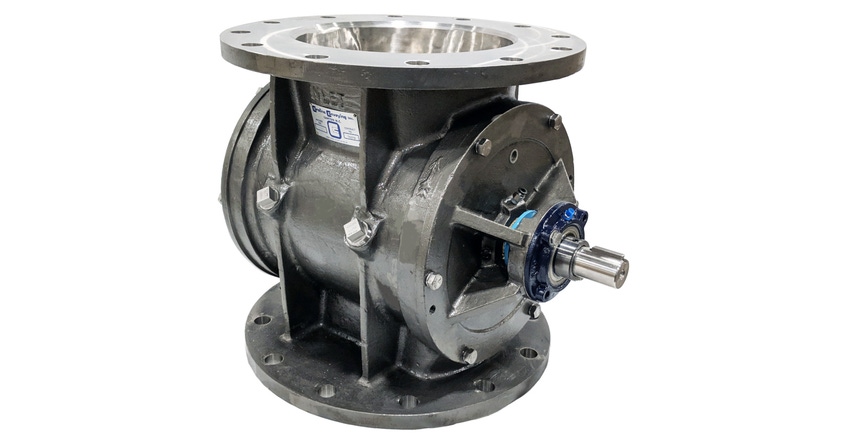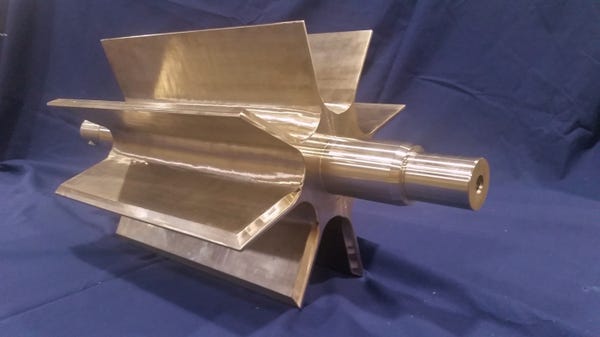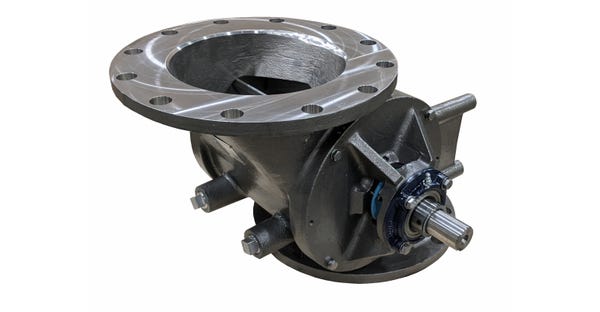What causes a rotary airlock to jam, how to prevent it, and options for handling large particulates
April 15, 2021

Paul Golden, sales manager, Carolina Conveying Inc.
Rotary airlock valves are a critical component of a material process, and it is often perceived that a valve is just a valve, and can be utilized on any number of different material handling systems. All types of valves include the same basic components: a body with an inlet and an outlet, two end plates, and a rotor with vanes, which in operation, the shaft is rotated via a motor and chain drive. As the vanes turn a volume of material passes through the valve inlet into the pockets of the rotor and is moved towards to outlet of the valve.
There are numerous configurations for valves, depending on the characteristics of the material to be handled. Most manufacturers offer valves with round, square, or rectangular inlet. Bodies are typically available in cast iron, cast aluminum, or cast stainless steel, and can have special coatings for abrasive products or highly polished finishes for the food and dairy industries. Rotors can be open- or closed-end type with at least six vanes, and can be fixed bladed or adjustable with steel and flexible tips, depending on the application. Rotary airlock valve types include drop thru, blow thru, and side entry – each with its own advantages and suitability for various applications.
Rotary airlock valves are designed to be used as an airlock, a metering device, or both. They are designed to minimize air leakage while allowing material to pass between different pieces of equipment at different pressures. The valve also acts as a metering device and will operate under a headload of material and regulates the flow of material at a desired rate between equipment with the same pressure.

Stainless open-end rotor
While it is a simple valve, all the components are precisely machined to create a tight, minimum running clearance between the rotor and housing. These tight tolerances are typically 0.004 to 0.006 in., which is the thickness of the average human hair. These small clearances are what create the “airlock” as they minimize air leakage between the inlet to outlet flange and still allow the passage of material through the valve. From dust collection systems to vacuum receivers to dilute pressure conveying systems, the rotary airlock valve allows the transfer of material with minimal air loss and allows the process to run continuously.
In this article, I will focus on what causes a rotary airlock to jam and how to prevent it, and discuss options for handling products that have larger particulates such as fibrous materials or hard materials such as plastic pellets, where shearing of product and jamming of valves are a major concern.
Most rotary airlock valves have tight tolerances between the rotor and the body housing as mentioned earlier, so when handling dust, powders, and small granules, the product passes through a conventional drop-thru type rotary airlock without any issues. Shearing and jamming occurs when hard, large particles are introduced and pinch between the rotating rotor vanes as they turn into the housing. This pinching action causes vibration, squealing, or even jamming, as well as damage to the product. Jamming can also occur when a valve is undersized. For example, a 3-in. lump is unable to pass through a 6-in. valve as the lump is larger than the size of the rotor pocket in the valve.
If you experience a jam in your operation, refer to the manufacturer’s operating and maintenance manual and check for common problems that occur such. Here are some questions to ask:
Is the valve running in the correct direction as per the manufacturer’s instructions?
Can you hear or see the valve vibrating? A vibrating sound indicates that there is a jam between valve and rotor vane and potentially damage will occur to the drive components and well as the valve interior.
Is the rotor turning normally without any increase in noise?
Is the material temperature higher than the valve was designed for? Thermal expansion will cause the rotor vanes to expand, which could cause them to come in contact with the end plates or housing and seize up, in which case the clearances must be increased beyond the standard 0.004 to 0.006 in.
Is the product smearing or building up on the internals? In this case the product is reducing the clearances to 0 in. and the rotor is constantly cutting away the buildup. Common products that smear are sugar, hydrated lime, and others.
As the internal rotor has very tight tolerances, it is also possible that the rotor has become misaligned and has started to rub against the housing. If that is the case, the rotor will require recentering in a timely manner. Otherwise you risk permanent damage to the valve and the possibility of metal shavings in your product.
It is also possible that jamming can occur months or even years after commissioning. Has the process changed in any manner--such as receiving material from a different supplier (which may have different properties such as moisture content) or the onset of cold weather in outdoor installations? Other potential occurrences of jamming can be due to a foreign material entering the process, such as a wrench or a welding rod, or even trash mixed in from your supplier.
There are a number of methods to reduce the potential problem of the valve jamming, depending on your process. Using a conventional drop-thru valve, you can fit flexible rubber material tips to an adjustable rotor such a polyurethane or Teflon, in a mechanical conveying application, or fit an inlet shear deflector that is fitted to the inlet of the rotary airlock and enables the material to avoid contact between the rotor vanes and the valve inlet. Another option is to meter the product into the rotary airlock so that the pockets are only partially filled, allowing the rotary airlock to minimize air leakage but no longer act as a metering device.

Side-entry rotary airlock
The best solution to prevent shearing and jamming is a side-entry rotary airlock, which is specifically designed to overcome this pinching problem and is also designed for use on positive pressure and vacuum/suction-type pneumatic conveying systems. The valve name comes from the inlet throat, which is completely shifted off center, allowing the product to enter the side of the rotor instead of the top. With the side-entry throat design, the product is caught on the upswing of the rotor vanes so that the product is constantly falling away from the shear point. This also reduces pocket fill, which reduces the likelihood of product shearing. The inlet throat also has a ‘V’ shape where the rotor enters the housing, which minimizes the pinch point and helps push product out of the way. The design of this valve decreases product shear, lessening the chance of shock loads, which can cause damage to the drive components. This valve is ideally suited for the plastics industry, whether handling virgin plastic pellets or regrind material in the recycling industries. It is also useful in handling fragile larger particles to minimize shearing where product damage is a concern.
Contact your valve manufacturer with any process concerns about possible product jamming to ensure that you have the right rotary airlock valve installed for your process. Common questions they should ask include the product being handled, bulk density, particle size distribution, if the product is friable, maximum temperature, pressure differential, discharge rate, and system layout. Depending on the product and particle size, a small sample may be requested for evaluation or a large sample in order to run trials. With the right application information, valve type, and design selection, most, if not all, jamming, shearing, and noise issues can be overcome.
Paul Golden is sales manager, Carolina Conveying Inc. (Canton, NC). For more information, call 828-235-1005 or visit carolinaconveying.com.
You May Also Like



